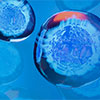BIOTIUM, INC
Supplier:
Biotium
Description:
This antibody reacts with Ig domain of CD47 protein. CD47, originally named integrin-associated protein (IAP), is a 50 kDa protein containing five membrane-spanning sequences and a short cytoplasmic tail. CD47 plays a role in both cell adhesion by acting as an adhesion receptor for THBS1 on platelets, and in the modulation of integrins. It is important in memory formation and synaptic plasticity in the hippocampus. CD47 may play a role in membrane transport and/or integrin dependent signal transduction.
CF® dyes are Biotium's next-generation fluorescent dyes. CF®488A is a green fluorescent dye (Ex/Em 490/515 nm) with excellent brightness and photostability. The dye is minimally charged for less non-specific binding. CF®488A also is compatible with super-resolution imaging by TIRF.
Supplier:
Biotium
Description:
CD66 Monoclonal antibody, Clone: C66/195, Host: Mouse, Species reactivity: Human, Monkey, Isotype: IgG1, kappa, Conjugate: CF594, Immunogen: Recom full-length human CEA, Synonyms: CEACAM5, CD66, Application: IF, Flow cytomet, Size: 100uL
Supplier:
Biotium
Description:
This MAb recognizes protein of 26 kDa-60 kDa, which is identified as CD63. Its epitope is different from that of MAb LAMP3/529. The tetraspanins are integral membrane proteins expressed on cell surface and granular membranes of hematopoietic cells and are components of multi-molecular complexes with specific integrins. The tetraspanin CD63 is a lysosomal membrane glycoprotein that translocates to the plasma membrane after platelet activation. CD63 is expressed on activated platelets, monocytes and macrophages, and is weakly expressed on granulocytes, T cell and B cells. It is located on the basophilic granule membranes and on the plasma membranes of lymphocytes and granulocytes. CD63 is a member of the TM4 superfamily of leukocyte glycoproteins that includes CD9, CD37 and CD53, which contain four transmembrane regions. CD63 may play a role in phagocytic and intracellular lysosome-phagosome fusion events. CD63 deficiency is associated with Hermansky-Pudlak syndrome and is strongly expressed during the early stages of melanoma progression.
CF® dyes are Biotium's next-generation fluorescent dyes. CF®405M is a blue fluorescent dye (Ex/Em 408/452 nm) with superior brightness and photostability compared to other blue dyes; it is also compatible with super-resolution imaging by SIM. Note: Conjugates of blue fluorescent dyes are not recommended for detecting low abundance targets, because blue dyes have lower fluorescence and can give higher non-specific background than other dye colors.
Supplier:
Biotium
Description:
This antibody recognizes a glycoprotein of 110 kDa, which is identified as CD68. It is important for identifying macrophages in tissue sections. It stains macrophages in a wide variety of human tissues, including Kupffer cells and macrophages in the red pulp of the spleen, in lamina propria of the gut, in lung alveoli, and in bone marrow. It reacts with myeloid precursors and peripheral blood granulocytes. It also reacts with plasmacytoid T cells, which are supposed to be of monocyte/macrophage origin. It shows strong granular cytoplasmic staining of chronic and acute myeloid leukemia and also reacts with rare cases of true histiocytic neoplasia. Lymphomas are negative or show few granules.
CF® dyes are Biotium's next-generation fluorescent dyes. CF®405S is a blue fluorescent dye (Ex/Em 404/431 nm) with superior brightness compared to other blue dyes; it is also compatible with super-resolution imaging by SIM. Note: Conjugates of blue fluorescent dyes are not recommended for detecting low abundance targets, because blue dyes have lower fluorescence and can give higher non-specific background than other dye colors.
Supplier:
Biotium
Description:
This MAb recognizes granulocyte-colony stimulating factor (G-CSF) in the cytoplasm of mature granulocytes. It shows no reactivity with any other cell types. Markers of myeloid cells are useful in the identification of different levels of cellular differentiation. It reacts with early precursor and mature forms of myeloid cells. It is useful for the detection of myeloid leukemias and granulocytic sarcomas. It can be used as a marker of granulocytes in normal tissues or inflammatory processes.G-CSF is a pleiotropic cytokine that influences differentiation, proliferation and activation of the neutrophilic granulocyte lineage. The human G-CSF cDNA encodes a 207 amino acid precursor containing a 29 amino acid signal peptide that is proteolytically cleaved to form a 178 amino acid residue mature protein. Two G-CSF's, which are identical except for a three amino acid deletion in the amino-terminus of one form of the protein have been isolated from human cells. Murine and human G-CSF's share 73% sequence identity at the amino acid level.
Supplier:
Biotium
Description:
This antibody recognizes CK1, CK5, CK10 and CK14. In normal epithelia, it stains stratified epithelia, myoepithelial cells and basal cells in the prostate gland and bronchi. This MAb shows no reactivity with hepatocytes, pancreatic acinar cells, proximal renal tubules, or endometrial glands; there is no reactivity with cells derived from simple epithelia. Mesenchymal tumors, lymphomas, melanomas, neural tumors, and neuroendocrine tumors are negative with this antibody. It stains myoepithelial cells and has been shown to be useful in distinguishing prostate adenocarcinoma from benign prostate. This antibody has also been useful in separating benign from malignant intraductal breast proliferations.
CF® dyes are Biotium's next-generation fluorescent dyes. CF®647 is a far-red fluorescent dye (Ex/Em 650/665 nm) with excellent brightness. It also is compatible with super-resolution imaging by STORM.
Supplier:
Biotium
Description:
Chromogranin A is present in neuroendocrine cells throughout the body, including the neuroendocrine cells of the large and small intestine, adrenal medulla and pancreatic islets. It is an excellent marker for carcinoid tumors, pheochromocytomas, paragangliomas, and other neuroendocrine tumors. Co-expression of chromogranin A and neuron specific enolase (NSE) is common in neuroendocrine neoplasms. Reportedly, co-expression of certain keratins and chromogranin indicates neuroendocrine lineage. The presence of strong anti-chromogranin staining and absence of anti-keratin staining should raise the possibility of paraganglioma. The co-expression of chromogranin and NSE is typical of neuroendocrine neoplasms. Most pituitary adenomas and prolactinomas readily express chromogranin.
Supplier:
Biotium
Description:
Chromogranin A is present in neuroendocrine cells throughout the body, including the neuroendocrine cells of the large and small intestine, adrenal medulla and pancreatic islets. It is an excellent marker for carcinoid tumors, pheochromocytomas, paragangliomas, and other neuroendocrine tumors. Co-expression of chromogranin A and neuron specific enolase (NSE) is common in neuroendocrine neoplasms. Reportedly, co-expression of certain keratins and chromogranin indicates neuroendocrine lineage. The presence of strong anti-chromogranin staining and absence of anti-keratin staining should raise the possibility of paraganglioma. The co-expression of chromogranin and NSE is typical of neuroendocrine neoplasms. Most pituitary adenomas and prolactinomas readily express chromogranin.
CF® dyes are Biotium's next-generation fluorescent dyes. CF®647 is a far-red fluorescent dye (Ex/Em 650/665 nm) with excellent brightness. It also is compatible with super-resolution imaging by STORM.
Supplier:
Biotium
Description:
Cdc20 Monoclonal antibody, Clone: CDC20/1102, Host: Mouse, Species reactivity: Human, Isotype: IgG1, kappa, Conjugate: CF647, Immunogen: Recombinant human Cdc20 protein, Synonyms: CDC20, CDC20A, p55CDC, P55CDC-LSB, Application: IF, IHC(formalin), FC, Size: 500 uL
Supplier:
Biotium
Description:
This antibody recognizes an epitope on the extracellular domain of gonadotropin releasing hormone (GnRH) receptor or luteinizing hormone receptor (LHCGR). Lutropin (also designated luteinizing hormone) plays a role in spermatogenesis and ovulation by stimulating the testes and ovaries to produce steroids. Gonadotropin (also designated choriogonadotropin) production in the placenta maintains estrogen and progesterone levels during the first trimester of pregnancy. Ovaries and testes abundantly express luteinizing hormone/choriogonadotropin receptor. GnRH receptor contains seven hydrophobic transmembrane domains connected by hydrophilic extracellular and intracellular loops characteristic of G-protein coupled receptors. GnRH stimulates the gonadotrophs of the anterior pituitary to secrete luteinizing hormone (LH) as well as follicle-stimulating hormone (FSH). GnRH influences the protective effect of pregnancy and Gonadotropin against breast cancer. The expression of GnRH on breast carcinoma correlates in part to the degree of tumor differentiation. GnRH-positive breast tumors occur more frequently in tumors with greater cell differentiation in premenopausal women. GnRH is present in luteal and granulosa cells as well as in ovarian cell membrane preparations.
CF® dyes are Biotium's next-generation fluorescent dyes. CF®568 is a red fluorescent dye (Ex/Em 562/583 nm) with superior brightness and photostability. It also is compatible with super-resolution imaging by STORM and TIRF.
Supplier:
Biotium
Description:
This antibody recognizes CK1, CK5, CK10 and CK14. In normal epithelia, it stains stratified epithelia, myoepithelial cells and basal cells in the prostate gland and bronchi. This MAb shows no reactivity with hepatocytes, pancreatic acinar cells, proximal renal tubules, or endometrial glands; there is no reactivity with cells derived from simple epithelia. Mesenchymal tumors, lymphomas, melanomas, neural tumors, and neuroendocrine tumors are negative with this antibody. It stains myoepithelial cells and has been shown to be useful in distinguishing prostate adenocarcinoma from benign prostate. This antibody has also been useful in separating benign from malignant intraductal breast proliferations.
Supplier:
Biotium
Description:
CD6 Monoclonal antibody, Clone: C6/372 + 3F7B5, Host: Mouse, Species reactivity: Human, Isotype: IgG's, Conjugate: CF594, Immunogen: Human recombinant CD6 protein ; Human rheumatoid synovial T cell line ST-1, Synonyms: T12, TP120, Application: IF, IHC, Size: 500 uL
Supplier:
Biotium
Description:
CD6 is a type I transmembrane glycoprotein that contains a 24-amino acid signal sequence, three extracellularscavenger receptor cysteine-rich(SRCR) domains, a membrane-spanning domain and a 44-amino acid cytoplasmic domain. The CD6 glycoprotein is tyrosine phosphorylated during TCR-mediated T cell activation. CD6 shows significant homology to CD5. CD6 is present on mature thymocytes, peripheral T cells and a subset of B cells. Antibodies to CD6 are used to deplete T cells from bone marrow transplants to prevent graft versus host disease.
CF® dyes are Biotium's next-generation fluorescent dyes. CF®647 is a far-red fluorescent dye (Ex/Em 650/665 nm) with excellent brightness. It also is compatible with super-resolution imaging by STORM.
Supplier:
Biotium
Description:
This antibody recognizes a protein of 30 kDa, identified as CD70. It is a cytokine that belongs to the tumor necrosis factor (TNF) ligand family. This cytokine is a ligand for TNFRSF27/CD27. It is a surface antigen on activated, but not on resting, T- and B-lymphocytes. It induces proliferation of co-stimulated T cells, enhances the generation of cytolytic T cells, and contributes to T cell activation. This cytokine is also reported to play a role in regulating B-cell activation, cytotoxic function of natural killer cells, and immunoglobulin synthesis.
Supplier:
Biotium
Description:
CD71 Monoclonal antibody, Clone: 66IG10, Host: Mouse, Species reactivity: Human, Isotype: IgG2b, kappa, Conjugate: CF647, Immunogen: Human thymocytes (T-cells), Synonyms: Mtvr-1, p90, TFR1, TFRC transferrin receptor (p90 CD71), TRFR, Application: IF, FC, Size: 100uL
Supplier:
Biotium
Description:
Cytokeratin 18 Monoclonal antibody, Clone: DA7, Host: Mouse, Species reactivity: Human, Isotype: IgG1, kappa, Conjugate: CF488A, Immunogen: Human breast cancer PMC 42 cells, Synonyms: K18, Application: IF, IHC, WB, FC, Size: 500 uL
Inquire for Price
Stock for this item is limited, but may be available in a warehouse close to you. Please make sure that you are logged in to the site so that available stock can be displayed. If the
Stock for this item is limited, but may be available in a warehouse close to you. Please make sure that you are logged in to the site so that available stock can be displayed. If the
You must log in to order restricted items. We request that you provide the required business documentation to purchase this product for the first time.
To order chemicals, medical devices, or other restricted products please provide identification that includes your business name and shipping address via email CMD_NA@vwr.com or fax 484.881.5997 referencing your VWR account number . Acceptable forms of identification are:
-Additional Documentation May be needed to purchase this item. A VWR representative will contact you if needed.
This product has been blocked by your organization. Please contact your purchasing department for more information.
The original product is no longer available. The replacement shown is available.
This product is currently unavailable but limited stock may be available in our extended warehouse network. Please call 1-800-932-5000 and a VWR Customer Service Representative will help you.
|
|||||||||


































